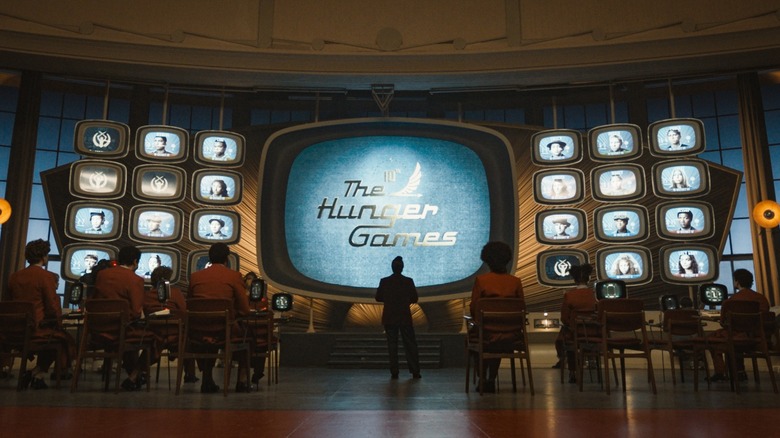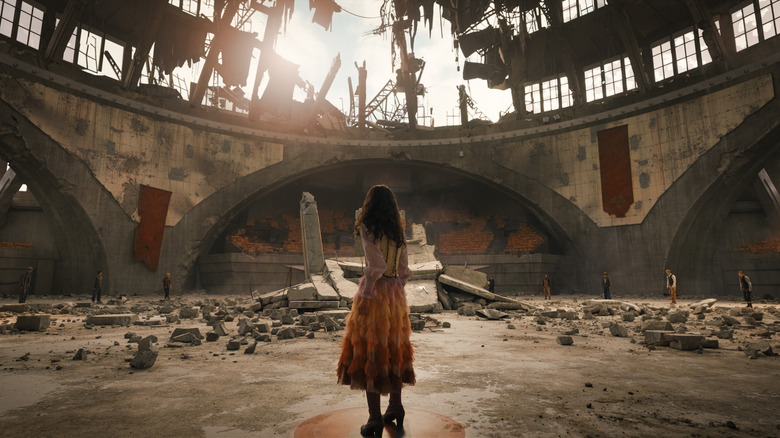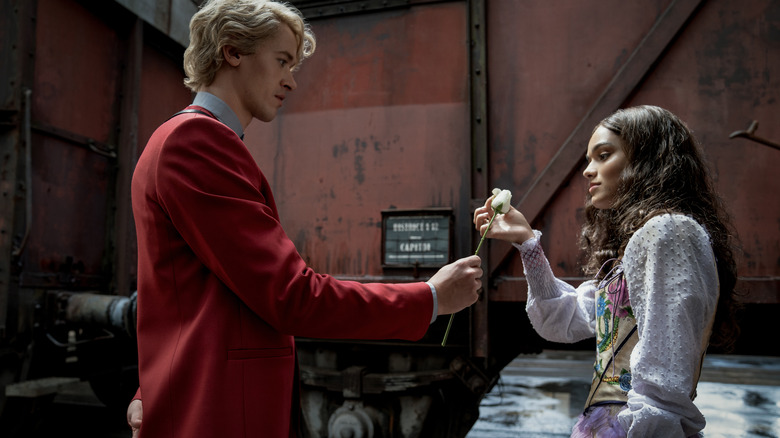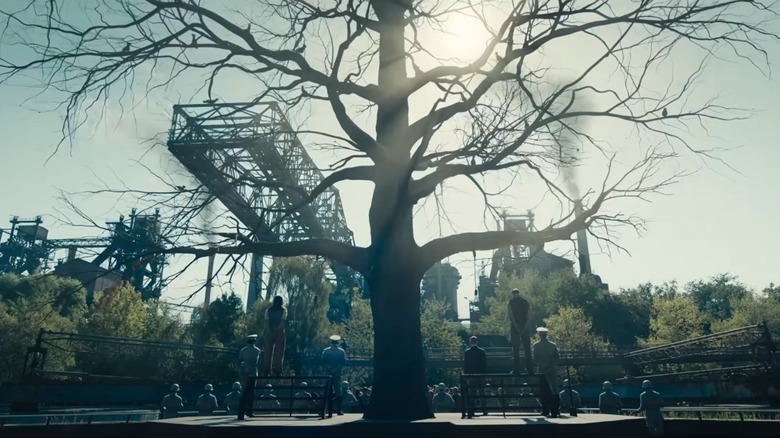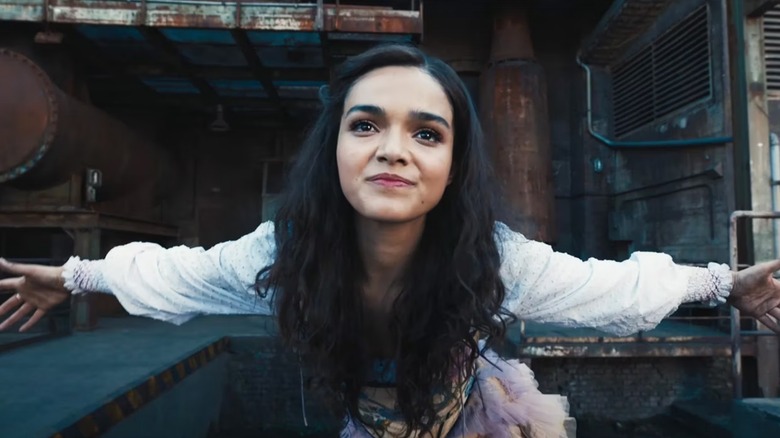What You Need To Remember From The Hunger Games To Watch The Ballad Of Songbirds And Snakes
Against all odds, the newest installment of "The Hunger Games" franchise is just about to arrive. Though "The Ballad of Songbirds and Snakes" releases almost exactly eight years after "Mockingjay Part 2," the prequel movie takes place roughly 60 years before Katniss Everdeen and her rebel friends brought the Capitol to its knees. Set only a decade after the Hunger Games were first mandated as a collective form of punishment for rebellion, the newest movie charts the rise of the young man who would eventually come to be known as President Coriolanus Snow, a role first portrayed by Donald Sutherland in the original series and now taken over by actor Tom Blyth. This is a very different status quo than the one fans were introduced to back in 2012 (or earlier, for those who devoured author Suzanne Collins' books beforehand), to say the least.
Although the movie works just fine without prior knowledge of the franchise (you can read my review of the film here), director Francis Lawrence clearly builds atop the foundation already set by the previous movies. By now, the basics of the world of "The Hunger Games" are pretty well-known, but this guide is meant for both newcomers and longtime fans alike — many of whom may not have revisited these movies since 2015. As with any successful YA franchise reliant on world-building, there are a lot of details to remember and not nearly enough time for a lengthy refresher. So here's everything you need to remember before heading out to catch "Songbirds and Snakes" in theaters.
The Games must go on
Everyone knows the Hunger Games are pretty nasty business. What this movie presupposes is ... maybe they were even worse? We all remember when Jennifer Lawrence's Katniss volunteered out of obscurity to risk her life in the arena back in the original 2012 movie. But compared to the lavish, almost royal treatment the so-called "tributes" received as they were whisked away to the Capitol and trained under the careful eye of seasoned mentors, the poor tributes of the tenth annual Hunger Games might as well have been fed to the wolves. "Songbirds and Snakes" uses our knowledge of the Capitol's decadence and their ability to hone the Games into a marketable spectacle against us at every turn, shocking viewers and characters alike with the minimalist and stripped-down trappings from a time when even those in charge didn't quite know what they wanted these Games to be.
In essence, however, the rules are all the same. A pair of tributes from each District are randomly (or not-so-randomly) selected to participate and hauled to the Capitol of Panem to fight to the death in a cruel, barbaric ritual meant as a harsh reminder of the First Rebellion. But rather than learning from mentors who themselves survived the Games in previous years, tributes in "Songbirds and Snakes" are given over to over-achieving students like Snow — not to help them survive, mind you, but to make them into the biggest spectacle possible. Otherwise, fans will recognize much earlier versions of familiar concepts like sponsorships providing survival tools or food, drones carrying such gifts into the arena, and live feeds broadcasting the event to the entire country ... all while the Head Gamemaker (here played by Viola Davis) attempts to turn such violence into soap-opera dramatics.
White roses
Every villain needs their signature, and Coriolanus Snow's symbol of choice comes loaded with meaning. Throughout the original "The Hunger Games" movies, we see the sinister President commonly associating himself with the pale flower. Early on, he's seen carrying a white rose on his lapel at all times. In the sequels, Snow takes this association even further and turns this into a sort of psychological warfare with Katniss, who's growing into more and more of a symbol herself. While visiting District 12 in "Catching Fire," Snow pays Katniss a personal visit and makes sure to leave a threatening white rose behind as a reminder of the danger he poses should she choose to act out against Capitol interests again. In "Mockingjay," a nighttime raid on the rebel stronghold in District 13 results in a particularly menacing touch. When Katniss makes it to the surface, she find the area covered in white roses. (In the book, they were red and pink.) Later on, it's revealed that Snow covers himself in the scent of roses to cover up the pervasive smell of blood from mouth sores — a result of poisoning the drinks of his political enemies, but still subjecting himself to the deadly substances (he later takes the antidote, though it's not always successful) in order to keep up appearances.
It's safe to say that the thematic connection rears its head again in "Songbirds and Snakes," though this time in much different circumstances. Long considered an association that draws back to Snow's own grandmother (whom we see in the film, played by Fionnula Flanagan), the scenes with her and Snow's cousin Tigris (Hunter Schafer) are sure to fill in a few important blanks. Oh, and speaking of which, that's the same Tigris we see in "Mockingjay Part 2."
Are you, are you, coming to the tree?
We first heard it in a show-stopping sequence in "Mockingjay Part 1," it became a staple of the marketing campaign for "Songbirds and Snakes," and now fans just might be set to actually see the infamous hanging tree in the upcoming prequel. Jennifer Lawrence's haunting performance of "The Hanging Tree" quickly became a popular single in the soundtrack, which transformed from a quiet, off-the-cuff moment of levity in the midst of war to a rallying cry for the entire rebellion. Naturally, putting "Songbirds and Snakes" into production provided an organic opportunity to integrate Rachel Zegler's take on the song this time around. The implication, of course, is that this folksong is something of an oral tradition in District 12. And in the context of Lucy Gray's rendition, "The Hanging Tree" has the feel of a love song tinged in darkness — in other words, a perfect embodiment of her romance with Snow.
The various trailers for the movie have also hinted at scenes set by a much more literal hanging tree. By debuting as the fifth film in this franchise, "Songbirds and Snakes" has the added benefit of bringing all sorts of weight to such loaded imagery. No matter what events might go down here, fans will likely have the lyrics of that melancholy melody ringing in their ears.
Take a bow
In an ironic twist of fate, neither Katniss Everdeen nor Lucy Gray Baird should've ever been in the Games in the first place. Neither participant from District 12 was chosen in the Reaping through fair and valid means — Katniss famously volunteered on behalf of her sister, while newcomers will just have to see how Lucy Gray ultimately gets thrown into the arena. Either way, although both characters couldn't possibly be more different from one another in terms of personality and temperament, they each carry a massive chip on their shoulder that they express in very similar ways.
In the original "The Hunger Games," Katniss' frustrations boil over while training in the Capitol before the Games. Tasked with winning over the sponsorships of wealthy patrons, her skillset with a bow and arrow might represent her only means of salvation. But when she fails to market herself in any meaningful way, she resorts to firing an arrow dangerously directly at the crowd before bowing with as much sarcasm as only Jennifer Lawrence could muster. In "Songbirds and Snakes," much has already been made of a direct callback to this moment after Lucy Gray is called up as a tribute. Needless to say, her amusingly similar bow as an act of defiance to the Capitol stands out as both a fitting character moment and a neat reference that packs in extra meaning for fans of the first film.
